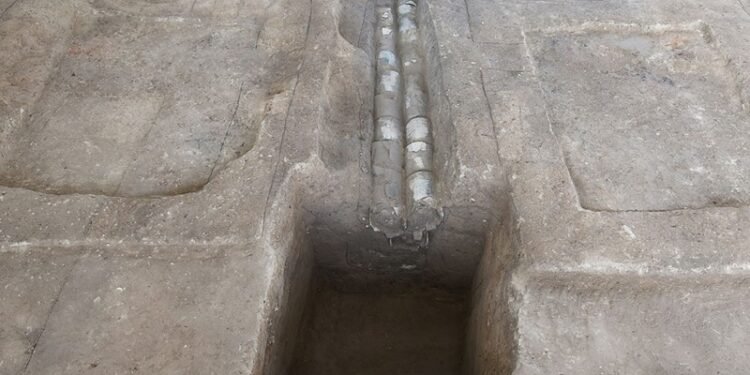A complex network of ceramic water pipes and drainage ditches at an ancient Chinese settlement proves that neolithic people were capable of significant engineering feats without the need for a centralised state authority, UCL researchers have said.
The infrastructure, which was found at the Chinese walled site of Pingliangtai, was created during the Longshan period about 4,000 years ago.
“The discovery of this ceramic water pipe network is remarkable because the people of Pingliangtai were able to build and maintain this advanced water management system with stone-age tools and without the organisation of a central power structure,” said Dr Yijie Zhuang of University College London (UCL), corresponding author on the paper.
“This system would have required a significant level of community-wide planning and coordination, and it was all done communally.”
The ceramic water pipes make up what is thought to be the oldest complete drainage system ever discovered in China. Made by interconnecting individual segments, the water pipes run along roads and walls to divert rainwater and show an advanced level of central planning at the neolithic site.
The researchers said that the settlement of Pingliangtai shows little evidence of social hierarchy. Its houses were uniformly small and show no signs of social stratification or significant inequality among the population. Excavations at the town’s cemetery also found no evidence of a social hierarchy in burials – a marked difference from excavations at other nearby towns of the same era.

Water pipes leading to a drainage ditch near Pingliangtai’s southern gate
Image credit: Yanpeng Cao
But despite the apparent lack of a centralised authority, the town’s population worked together to produce the ceramic pipes, plan their layout and install and maintain them.
The level of complexity associated with these pipes refutes an earlier understanding in archaeological fields that only a centralised state power with governing elites would be able to muster the organisation and resources to build a complex water management system.
Other ancient societies with advanced water systems tended to have a stronger, more centralised governance, or even despotism, the researchers said.
Peking University’s Dr Hai Zhang, co-author on the research, said: “Pingliangtai is an extraordinary site. The network of water pipes shows an advanced understanding of engineering and hydrology that was previously only thought possible in more hierarchical societies.”
Pingliangtai is located in what is now the Huaiyang District of the city of Zhoukou in central China.
During neolithic times, the town was home to about 500 people, with protective earthen walls and a surrounding moat. Situated on the Upper Huai River Plain on the vast Huang Huai Hai Plain, the area’s climate 4,000 years ago was marked by big seasonal climate shifts, where summer monsoons would commonly dump half a metre of rain on the region monthly.
Managing these deluges was important to prevent floodwaters from overwhelming the region’s communities. To do this, the inhabitants of Pingliangtai built and operated a two-tier drainage system that was unlike any other seen at the time. They built simple but coordinated lines of drainage ditches that ran parallel to their rows of houses in order to divert water from the residential area to a series of ceramic water pipes that carried the water into the surrounding moat, and away from the village.
These ceramic water pipes represented an advanced level of technology for the time. While there was some variety in decoration and styles, each pipe segment was about 20-30cm in diameter and 30-40cm in length. Numerous segments were slotted into each other to transport water over long distances.
Researchers cannot say specifically how the people of Pingliangtai organised and divided the labour among themselves to build and maintain this type of infrastructure. This kind of communal coordination would also have been necessary to build the earthen walls and moat surrounding the village as well.
The Pingliangtai drainage system was unique from water systems elsewhere in the world at the time. Its purpose – to drain rain and flood water from monsoons – differed from other neolithic systems in the world, many of which were used for sewerage water drainage or other purposes.
Sign up to the E&T News e-mail to get great stories like this delivered to your inbox every day.










